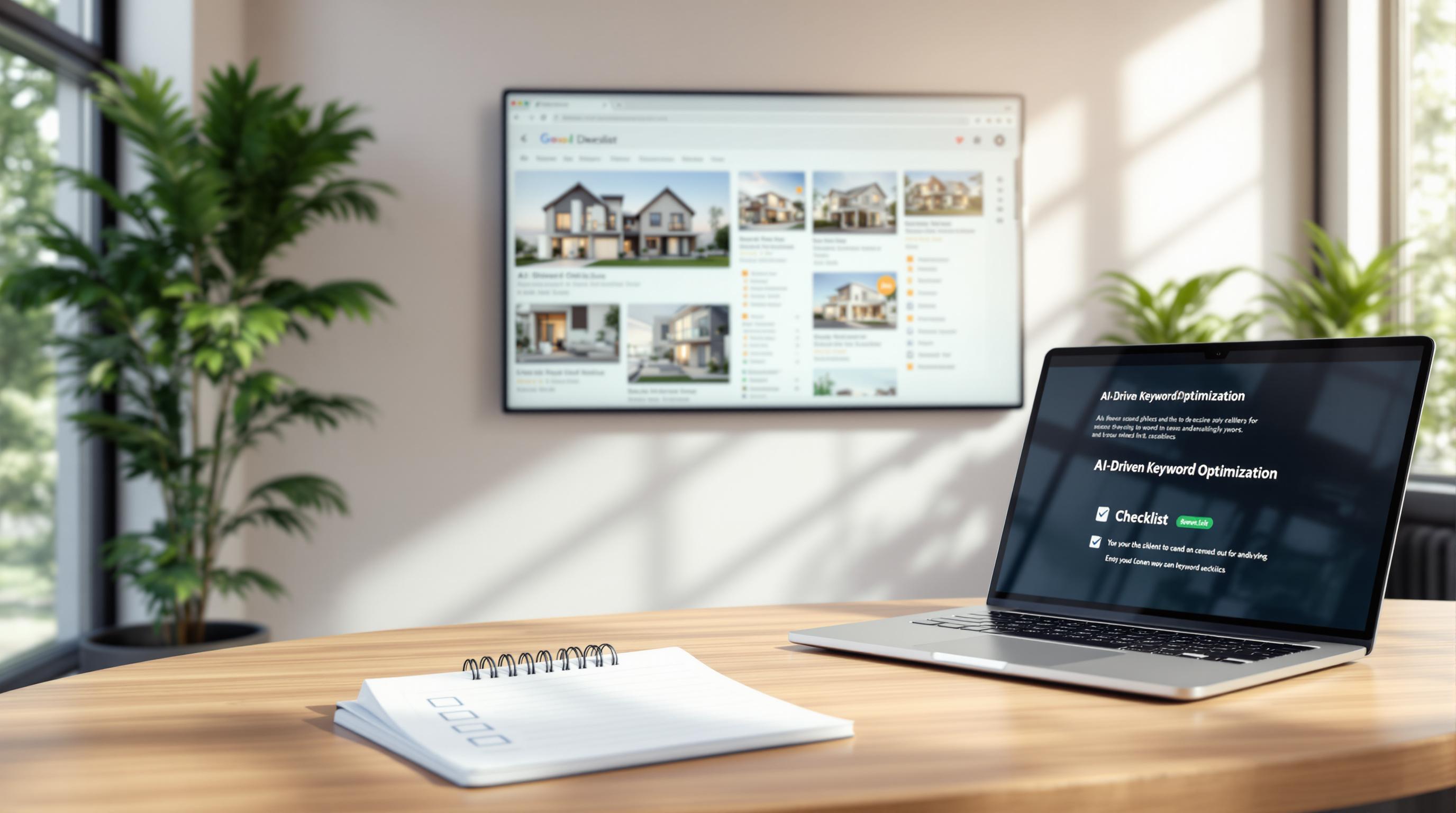AI-powered virtual tours are transforming real estate by making property viewing interactive, accessible, and data-driven. Here's what you need to know:
- What They Do: Combine 360-degree visuals, voice interaction, and data insights to improve buyer engagement and decision-making.
- Top Tools: Platforms like CubiCasa, UTour, and qbiq help agents create immersive tours with features like voice navigation, 3D layouts, and buyer behavior tracking.
- Key Benefits:
- Showcase properties 24/7, breaking geographical barriers.
- Tailor tours to individual buyer preferences.
- Use analytics to refine marketing strategies.
- How to Maximize Impact: Share tours across multiple platforms, ensure compatibility on all devices, and use AI to automate lead capture and engagement.
These tools are reshaping how buyers explore properties, speeding up decisions, and helping agents close deals faster. Dive into the article to learn how to choose and use the best tools for your needs.
Game-Changing AI for Virtual Tours
Top AI Tools for Virtual Tour Creation
AI-powered tools are changing the game for real estate professionals by making it easier to create immersive virtual tours. These platforms combine cutting-edge imaging technology with artificial intelligence to help agents showcase properties in a whole new way.
AI Platforms for Building Virtual Tours
CubiCasa is a tool that transforms property photos into detailed floor plans and 3D tours using AI. It's a quick and efficient way for agents to produce high-quality results.
qbiq goes a step further by offering AI-driven space planning. It allows users to create interactive 3D tours with customizable layouts, making it a great option for both residential and commercial properties. Tools like UTour take things further by enhancing how buyers experience these virtual tours.
Interactive Tools for Virtual Tours
UTour's AI Assistants bring a new level of interactivity to virtual tours. They offer voice-activated navigation, instant access to property details, and even insights about the surrounding community. For agents looking to explore more options, specialized directories provide a curated selection of tools designed to enhance virtual tour strategies.
AI Tool Directory for Real Estate Agents
The AI Tools For Real Estate Agents directory is a great resource. It features tools like Dialzara and Epique, which provide functionalities such as virtual staging, automated social sharing, lead capture, and viewer analytics. These features help agents streamline their marketing and engagement efforts while simplifying workflows.
AI-powered solutions have already been used in projects like The Parker in Boston and Sandbank Villas in Zanzibar. These projects utilized virtual staging and 360-degree tours to attract more interest and speed up the sales process.
sbb-itb-db182b0
Tips for Using AI in Virtual Tours
Customizing Tours for Buyers
AI tools allow real estate agents to craft virtual tours tailored to individual buyer preferences. Platforms like qbiq let agents highlight specific features and adjust layouts to suit what buyers are looking for. This makes the experience more engaging and relevant.
For instance, if a buyer is keen on home office spaces, AI can focus on showcasing those areas during the tour. These systems also learn from how viewers interact, improving the experience over time.
In addition to creating tailored tours, AI provides insights that can refine marketing strategies.
Using Data to Improve Marketing
Tools like RICOH360 Tours track buyer behavior to uncover patterns such as how long viewers spend in certain areas, how they navigate the space, and where they interact most. Here's a quick breakdown:
| Metric Type | What It Reveals |
|---|---|
| Viewing Duration | Which areas hold the most interest |
| Navigation Patterns | How viewers move through the space |
| Interaction Points | Key spots where viewers engage |
These insights help agents pinpoint popular features, improve tour flow, and focus their marketing efforts where it matters most.
"AI tools are leveling the playing field for real estate professionals by providing actionable insights that were previously unavailable",
says Jeff Allen, President of CubiCasa.
Once you've gathered these insights, the next step is making sure your virtual tours are seen by the right audience.
Adding Virtual Tours to Marketing Channels
To get the most out of virtual tours, distributing them across the right platforms is key. AI-powered tools can automate this process, ensuring the tours are optimized for each platform. For example, UTour's AI Assistants adjust virtual tours to fit various marketing channels while keeping them interactive and informative.
When integrating virtual tours into your marketing strategy, consider:
- Ensuring tours are easy to view on all devices and platforms.
- Showcasing features like voice-activated navigation and AI-driven assistance.
- Using built-in tools to capture leads and track engagement effectively.
These steps can help you maximize the reach and impact of your virtual tours.
Why AI-Powered Virtual Tours Are Useful
Keeping Buyers Interested
AI-powered virtual tours turn property viewing into an interactive and engaging process. Features like 360-degree views and customizable navigation make it easy for buyers to explore properties in a way that suits their preferences. Plus, high-quality visuals and 3D models create an experience that feels almost like being there in person.
These tools don't just grab attention - they also make the decision-making process much smoother.
Helping Buyers Make Decisions
Virtual tours powered by AI provide detailed insights into key property aspects like layouts, lighting, and unique features. This allows buyers to evaluate properties more efficiently and make decisions with confidence, cutting down the time needed to move forward.
"AI-powered virtual tours enable clients to make informed decisions more quickly, significantly reducing the time it takes to close deals", highlights a study on real estate technology adoption.
And while they're helpful for local buyers, these tools are a game-changer for those purchasing from a distance.
Reaching Buyers in Other Locations
AI-driven virtual tours eliminate the barriers of distance in real estate. Tools like Matterport let remote buyers explore highly detailed 3D models as if they were walking through the property themselves. This is especially useful for international buyers or commercial properties, helping to reduce vacancy times and align expectations early on.
Conclusion: Using AI to Improve Virtual Tours
AI-powered virtual tours are transforming how properties are showcased, making it easier for buyers to visualize spaces and for agents to connect with potential clients. This shift is a game-changer as the real estate industry moves further into the digital age.
Take luxury properties like The Parker in Boston, for example. They use AI-driven virtual staging to showcase design possibilities, sparking buyer interest and boosting engagement. These tools work best when paired with smart marketing strategies and data analytics.
The AI Tools For Real Estate Agents directory is a great resource for finding tools that simplify virtual tour creation and improve marketing efforts.
"AI-powered virtual tours enable clients to make informed decisions more quickly, significantly reducing the time it takes to close deals", recent research highlights.
To get the most out of virtual tours, integrate features like interactive elements, data insights, and multi-channel promotion. These strategies can make virtual tours even more effective.
As AI continues to evolve, expect virtual tours to include advanced features like augmented reality and tailored recommendations. Real estate professionals who adopt these tools now will be better equipped to meet shifting buyer needs and stay ahead in a competitive market.


